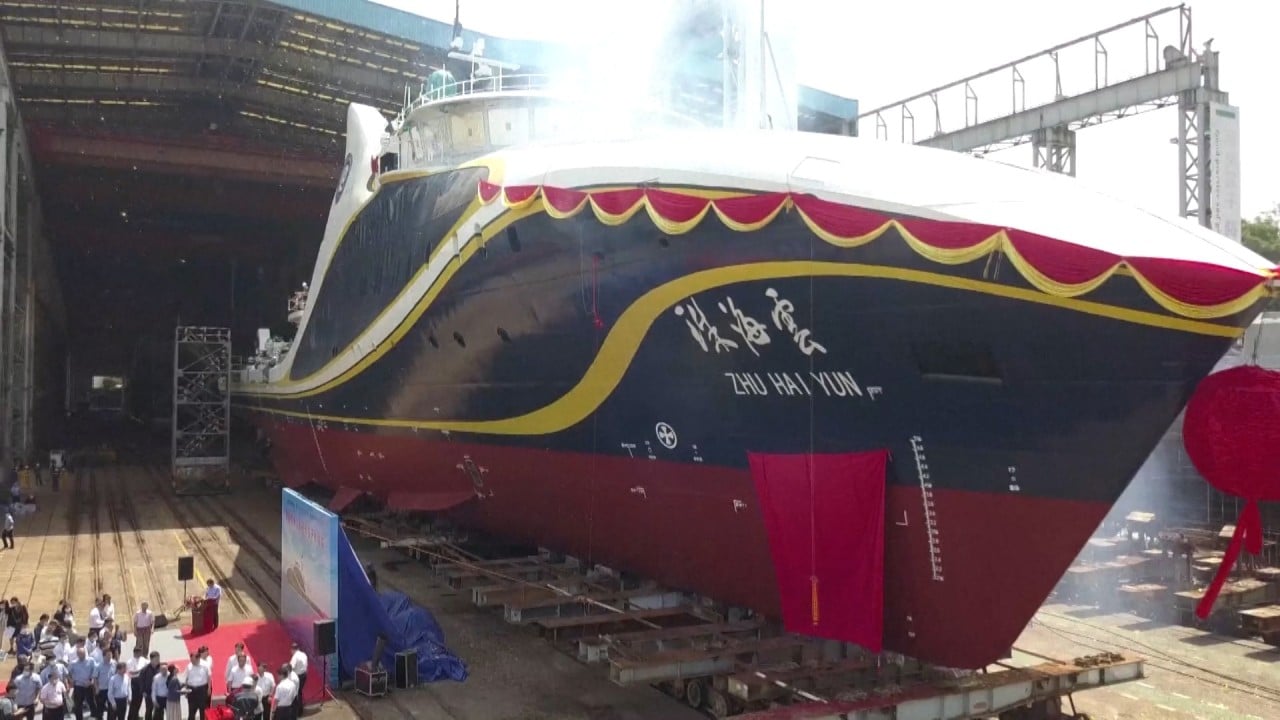
Does China’s new drone mother ship have potential as a military vessel?
- Ship has capacity to carry dozens of airborne, surface and underwater drones, with domestic media spelling out benefits for environmental and ocean floor studies
- Autonomous vessel Zhu Hai Yun had the same risk of electronic jamming as all other unmanned vessels, says US think tank security analyst
Last week, China launched the world’s first drone carrier, named Zhu Hai Yun, a vessel that can be controlled remotely to navigate autonomously in open water. It is expected to be delivered by the end of the year after completing sea trials.
The state-run Science and Technology Daily said the ship could be an efficient tool in marine disaster prevention and mitigation, environmental monitoring and offshore wind farm maintenance as well as delivering accurate marine information.
The ship is 88.5 metres long, 14 metres wide and 6.1 metres deep (290 feet long, 46 feet wide and 20 feet deep), with a designed displacement of 2,000 tonnes. It can sail at a speed of 13 knots, with a top speed of 18 knots, similar to the speed of a container ship.
The country has also developed underwater gliders that can take sonar soundings of the bottom of the ocean to get an accurate depth map of the sea floor. It can use sensors to understand thermal conditions within the water and acoustic conditions to give PLA Navy submarines the best chance for traversing the ocean undetected.
China’s military looks for new drones, intelligent vehicles for logistics
Timothy Heath, a senior security analyst from US think tank Rand, said the drone mother ship could definitely be used for military applications.
“The drone carrier might deploy to remote locations to deploy smart mines, for example,” he said.
“The most immediate benefit to the PLA is the increase in knowledge about relevant waters through the collection of data by the UUVs [unmanned underwater vehicles]. This can help PLA Navy submarines operate with greater confidence and effectiveness in those areas.”
However, Heath added that this autonomous ship had the same risk of electronic jamming as all other unmanned vessels.
“With no human on board, the vessel in autonomous mode could make bad decisions in the face of unexpected circumstances, resulting in mission failure,” he said.
Besides jamming, drones could be spoofed – when its communication link is hijacked and control of the vehicle is taken over – or destroyed by lasers or other weapons.
However, Zhou Chenming, a researcher from the Yuan Wang military science and technology think tank, disagreed and said the Zhu Hai Yun could not be deployed by the military.
“This ship can at most be deployed to relatively stable waters near the shore, where most of the warfare or conflict won’t occur,” Zhou said. “I think this vessel’s biggest contribution is the replacement of the increasingly expensive labour cost in economic or commercial activities in the near seas.”
Chinese drones in demand as Algeria and Egypt eye orders of UAVs
Regardless of the debate over potential military uses for the Zhu Hai Yun, China remains the world’s biggest shipbuilder and it is rising as a “maritime great power”. The country has invested heavily in developing research vessels in recent years.
Last year, Zhuhai Yunzhou Intelligence Technology, a leading developer of unmanned surface vehicles, announced it had developed an unmanned high-speed vessel, a breakthrough in its “dynamic cooperation confrontation technology”, according to state-owned Global Times.
The report said the vessel could quickly intercept, besiege and expel invasive targets, and it marked a milestone in the development of unmanned maritime intelligence equipment.



